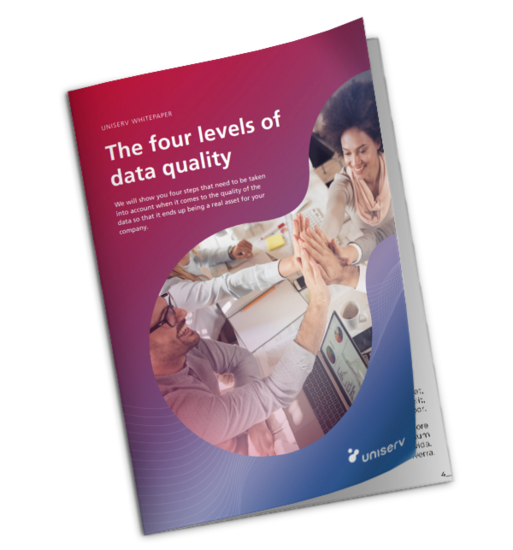Data Enrichment
Make customer data more valuable with optimized first- and third-party data
Data enrichment allows you to update your data, create more accurate customer profiles, and open up better opportunities for analysis and visualization. Data enrichment also serves as a means of quality assurance.

Why data enrichment?
Data enrichment involves supplementing customer and prospect data with additional information from internal and external sources. This is not an end in itself, but creates added value and new insights about your customers and prospects. This is because data often only reveals its full potential through data enrichment. Simple information becomes valuable insights. In addition, data enrichment enables advanced analytics and data visualizations, refines customer profiles, and supports targeted marketing strategies and data-driven decisions, such as:
- You want to analyze your inventory data, e.g., in terms of purchasing power and sales potential.
- You want to learn more about the living conditions and habits of your customers and prospects.
- You want to aggregate your data in a meaningful way and prepare it for household formation.
- You want to define your target groups even more precisely and address them more specifically for your next marketing campaigns.
- You want to create a basis for decision-making for further business development, e.g., where best to open a new branch.

Data enrichment vs. data enhancement
Just playing with words?
In everyday data management, the terms data enrichment and data enhancement often appear in connection with the topic of data enrichment. Both refer essentially to data enrichment, i.e., measures taken to improve or supplement existing data in order to generate further benefits. However, there are subtle differences that are particularly relevant in professional environments, such as marketing automation, data analysis, CRM systems, and data governance.
Data enrichment: focus on content supplementation
In data enrichment, “data enrichment” refers to the addition of information. Existing data sets are enriched with additional attributes or external sources. The aim is to gain more knowledge about existing entities such as individuals or companies. A customer or prospect data record is supplemented with socio-demographic characteristics, geocoordinates, or data on purchasing behavior.
Data enhancement: focus on qualitative improvement
In addition to pure data enrichment, the term ‘data enhancement’ also includes the correction and standardization of data, including data cleansing. The declared goal is to increase data quality and usability. An incorrect or incomplete data record is cleaned up, standardized (e.g., spelling), updated with current information, and, in the best case, also enriched.
Geocoding – focused data enrichment with geographical added value
Geocoding is a form of contextual data enrichment in which existing address data is supplemented with additional spatial information. This opens up completely new application possibilities:
- Location analyses: Where do my customers come from? Where would it be worthwhile to open a branch?
- Route optimization and logistics: Which delivery routes are efficient?
- Targeting in marketing: Which target groups live in which environments?
- Risk assessment: In which regions are flood risks or fraud probabilities higher, for example?
- Visualization on maps: Data points can be displayed and analyzed on maps in real time.
Data enrichment requires clean data – and that's what data cleansing does. It removes duplicates, corrects errors, standardizes formats, adds missing values, checks content against references, normalizes entries, and documents all steps. This creates a reliable database for enrichment, analysis, and automated processes. Order creates trust and usability.
Quick facts about data enrichment
- “Address” becomes “insight”: A simple postal address can become the basis for targeted marketing, location analyses, and purchasing power or lifestyle assessments.
- Tangible instead of anonymous: Continuous data enrichment creates the basis for individual experiences that truly inspire customers.
- External meets internal: Data enrichment combines your own data with preferably external sources, such as socio-demographic characteristics or economic data.
- Added value instead of extra work: Automated data enrichment processes deliver fresh insights – without any manual maintenance and with maximum scalability.
- Context makes the difference: A single data point is often meaningless, but adding relevant additional information creates real value. Statements and conclusions are now data-driven.
- Data governance & data enrichment: Data enrichment should be part of a comprehensive data strategy that includes control, documentation, and monitoring.

What data can be used for data enrichment?
Enriching customer and prospect data is not a rigid concept—it is extremely versatile. In principle, almost any type of data can be enriched, provided that there is meaningful, relevant additional information. Whether it's customers or prospects, and the associated locations or processes, every type of data can be made more intelligent. The context is always crucial: What are your goals for the data?
Customer and prospect data is a classic example of data enrichment. Typical additions can include sociodemographic characteristics, but also behavioral data and information about interests or affinities. The enriched data is used in particular for better targeting, personalized communication, and improved segmentation.
For sales, risk management, and partner networks, company-related data sets can be enriched with industry classifications such as NACE codes. This also includes credit ratings or payment history, as well as ownership structures or corporate affiliations. The data can then be used for lead scoring, lead management, risk assessment, and market analysis, for example.
Addresses or coordinates can be enriched with catchment areas and infrastructure data, for example. Microcensus information, economic data, and competitor locations are also available. This is useful for logistics, expansion, and location analysis. The supplemented data can be used to optimize supply chains, select locations, and plan target groups and potential.
For better planning, forecasting, and context analysis, customer and prospect data can also be enriched with information such as holidays, vacation periods, and weather data. Market and industry trends, seasonality, and historical developments can also be included. This data is useful for reporting, forecasting, and seasonal planning, for example.
The four levels of data quality
We will show you four steps that must be taken into account when it comes to the quality of the data so that it ultimately becomes a real asset for your company. Only the best for your data.
Download the Uniserv Business Whitepaper now.
Advantages of data enrichment
In today's data-driven business world, pure data sets, even if they are optimized in terms of quality, are often not enough. They only provide a snapshot of reality – incomplete, isolated, and sometimes difficult to interpret. Data enrichment transforms this raw data into valuable information. The advantages are manifold:
You might also be interested in:





